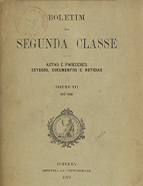

................................
The year 1910 was, unsurprisingly, dedicated to the centenary of Alexandre Herculano's birth. Issue no. 3 of Volume III (February) is entirely devoted to texts about the renowned historian (pp. 145–279). Issues 1, 3, and 4 include a three-part study by David Lopes titled Os árabes nas obras de Alexandre Herculano [The Arabs in the Works of Alexandre Herculano], one of the author's early works, where he applies the philological method and his knowledge of the Arabic language. Herculano's polemics with José Joaquim Costa de Macedo and António Caetano Pereira are also discussed.
The publications of 1911 reflect the emergence of new values brought to prominence by the establishment of the Republic. One notable theme is the increased recognition of women in society and culture. A comprehensive dossier is dedicated to Carolina Michaëlis de Vasconcelos, who is subsequently proposed as a corresponding member (Vols. IV and V, 1911 and 1912). Although times had changed, her entry into the Academy seems to require justification through an extensive array of texts by and about her. Notably, Maria Amália Vaz de Carvalho was the first Portuguese woman to be proposed and elected as a Corresponding Member (sic). The Count of Sabugosa underscores his symbolic role as one of the "41st fauteuil" of the immortals of the French Academy, due to his presence at the Convent of Jesus, the ACL's headquarters, during the reign of King Luís. Sabugosa, one of life's self-proclaimed "losers," firmly rejects excluding women from "scientific, literary, and academic guilds, the full cloister of the University, the liberal professions, honorary military orders, or the cenacles of letters" (Vol. VI, 1912, pp. 474–483).
This work is financed by national funds through FCT - Foundation for Science and Technology, I.P, in the scope of the projects UIDB/04311/2020 and UIDP/04311/2020.
